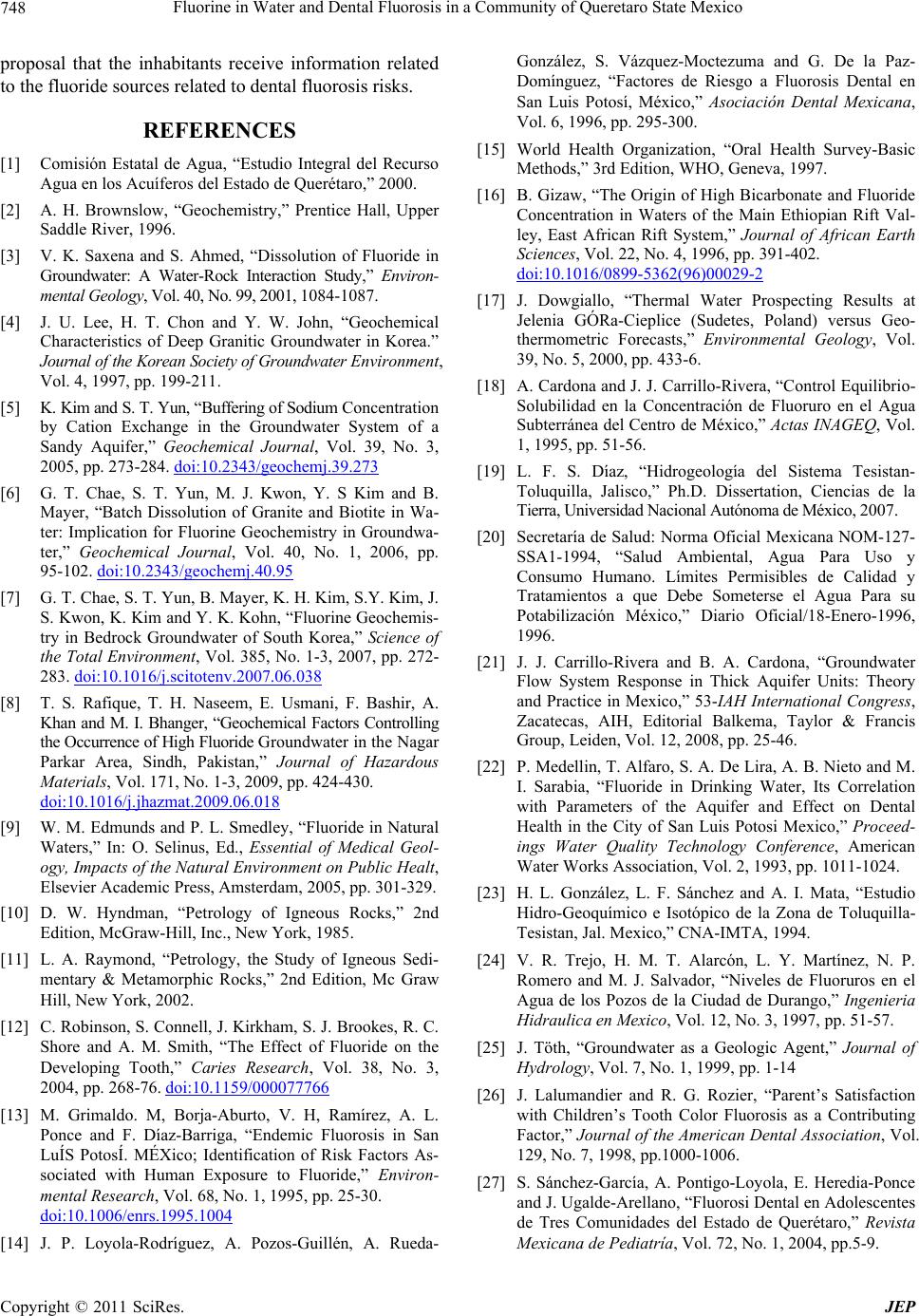
Fluorine in Water and Dental Fluorosis in a Community of Queretaro State Mexico
748
proposal that the inhabitants receive information related
to the fluoride sources related to dental fluorosis risks.
REFERENCES
[1] Comisión Estatal de Agua, “Estudio Integral del Recurso
Agua en los Acuíferos del Estado de Querétaro,” 2000.
[2] A. H. Brownslow, “Geochemistry,” Prentice Hall, Upper
Saddle River, 1996.
[3] V. K. Saxena and S. Ahmed, “Dissolution of Fluoride in
Groundwater: A Water-Rock Interaction Study,” Environ-
mental Geology, Vol. 40, No. 99, 2001, 1084-1087.
[4] J. U. Lee, H. T. Chon and Y. W. John, “Geochemical
Characteristics of Deep Granitic Groundwater in Korea.”
Journal of the Korean Society of Groundwater Env i r on m e nt ,
Vol. 4, 1997, pp. 199-211.
[5] K. Kim and S. T. Yun, “Buffering of Sodium Concentration
by Cation Exchange in the Groundwater System of a
Sandy Aquifer,” Geochemical Journal, Vol. 39, No. 3,
2005, pp. 273-284. doi:10.2343/geochemj.39.273
[6] G. T. Chae, S. T. Yun, M. J. Kwon, Y. S Kim and B.
Mayer, “Batch Dissolution of Granite and Biotite in Wa-
ter: Implication for Fluorine Geochemistry in Groundwa-
ter,” Geochemical Journal, Vol. 40, No. 1, 2006, pp.
95-102. doi:10.2343/geochemj.40.95
[7] G. T. Chae, S. T. Yun, B. Mayer, K. H. Kim, S.Y. Kim, J.
S. Kwon, K. Kim and Y. K. Kohn, “Fluorine Geochemis-
try in Bedrock Groundwater of South Korea,” Science of
the Total Environment, Vol. 385, No. 1-3, 2007, pp. 272-
283. doi:10.1016/j.scitotenv.2007.06.038
[8] T. S. Rafique, T. H. Naseem, E. Usmani, F. Bashir, A.
Khan and M. I. Bhanger, “Geochemical Factors Controlling
the Occurrence of High Fluoride Groundwater in the Nagar
Parkar Area, Sindh, Pakistan,” Journal of Hazardous
Materials, Vol. 171, No. 1-3, 2009, pp. 424-430.
doi:10.1016/j.jhazmat.2009.06.018
[9] W. M. Edmunds and P. L. Smedley, “Fluoride in Natural
Waters,” In: O. Selinus, Ed., Essential of Medical Geol-
ogy, Impacts of the Natural Environment on Public Healt,
Elsevier Academic Press, Amsterdam, 2005, pp. 301-329.
[10] D. W. Hyndman, “Petrology of Igneous Rocks,” 2nd
Edition, McGraw-Hill, Inc., New York, 1985.
[11] L. A. Raymond, “Petrology, the Study of Igneous Sedi-
mentary & Metamorphic Rocks,” 2nd Edition, Mc Graw
Hill, New York, 2002.
[12] C. Robinson, S. Connell, J. Kirkham, S. J. Brookes, R. C.
Shore and A. M. Smith, “The Effect of Fluoride on the
Developing Tooth,” Caries Research, Vol. 38, No. 3,
2004, pp. 268-76. doi:10.1159/000077766
[13] M. Grimaldo. M, Borja-Aburto, V. H, Ramírez, A. L.
Ponce and F. Díaz-Barriga, “Endemic Fluorosis in San
LuÍS PotosÍ. MÉXico; Identification of Risk Factors As-
sociated with Human Exposure to Fluoride,” Environ-
mental Research, Vol. 68, No. 1, 1995, pp. 25-30.
doi:10.1006/enrs.1995.1004
[14] J. P. Loyola-Rodríguez, A. Pozos-Guillén, A. Rueda-
González, S. Vázquez-Moctezuma and G. De la Paz-
Domínguez, “Factores de Riesgo a Fluorosis Dental en
San Luis Potosí, México,” Asociación Dental Mexicana,
Vol. 6, 1996, pp. 295-300.
[15] World Health Organization, “Oral Health Survey-Basic
Methods,” 3rd Edition, WHO, Geneva, 1997.
[16] B. Gizaw, “The Origin of High Bicarbonate and Fluoride
Concentration in Waters of the Main Ethiopian Rift Val-
ley, East African Rift System,” Journal of African Earth
Sciences, Vol. 22, No. 4, 1996, pp. 391-402.
doi:10.1016/0899-5362(96)00029-2
[17] J. Dowgiallo, “Thermal Water Prospecting Results at
Jelenia GÓRa-Cieplice (Sudetes, Poland) versus Geo-
thermometric Forecasts,” Environmental Geology, Vol.
39, No. 5, 2000, pp. 433-6.
[18] A. Cardona and J. J. Carrillo-Rivera, “Control Equilibrio-
Solubilidad en la Concentración de Fluoruro en el Agua
Subterránea del Centro de México,” Actas INAGEQ, Vol.
1, 1995, pp. 51-56.
[19] L. F. S. Díaz, “Hidrogeología del Sistema Tesistan-
Toluquilla, Jalisco,” Ph.D. Dissertation, Ciencias de la
Tierra, Universidad Nacional Autónoma de México, 2007.
[20] Secretaría de Salud: Norma Oficial Mexicana NOM-127-
SSA1-1994, “Salud Ambiental, Agua Para Uso y
Consumo Humano. Límites Permisibles de Calidad y
Tratamientos a que Debe Someterse el Agua Para su
Potabilización México,” Diario Oficial/18-Enero-1996,
1996.
[21] J. J. Carrillo-Rivera and B. A. Cardona, “Groundwater
Flow System Response in Thick Aquifer Units: Theory
and Practice in Mexico,” 53-IAH International Congress,
Zacatecas, AIH, Editorial Balkema, Taylor & Francis
Group, Leiden, Vol. 12, 2008, pp. 25-46.
[22] P. Medellin, T. Alfaro, S. A. De Lira, A. B. Nieto and M.
I. Sarabia, “Fluoride in Drinking Water, Its Correlation
with Parameters of the Aquifer and Effect on Dental
Health in the City of San Luis Potosi Mexico,” Proceed-
ings Water Quality Technology Conference, American
Water Works Association, Vol. 2, 1993, pp. 1011-1024.
[23] H. L. González, L. F. Sánchez and A. I. Mata, “Estudio
Hidro-Geoquímico e Isotópico de la Zona de Toluquilla-
Tesistan, Jal. Mexico,” CNA-IMTA, 1994.
[24] V. R. Trejo, H. M. T. Alarcón, L. Y. Martínez, N. P.
Romero and M. J. Salvador, “Niveles de Fluoruros en el
Agua de los Pozos de la Ciudad de Durango,” Ingenieria
Hidraulica en Mexico, Vol. 12, No. 3, 1997, pp. 51-57.
[25] J. Töth, “Groundwater as a Geologic Agent,” Journal of
Hydrology, Vol. 7, No. 1, 1999, pp. 1-14
[26] J. Lalumandier and R. G. Rozier, “Parent’s Satisfaction
with Children’s Tooth Color Fluorosis as a Contributing
Factor,” Journal of the American Dental Association, Vol.
129, No. 7, 1998, pp.1000-1006.
[27] S. Sánchez-García, A. Pontigo-Loyola, E. Heredia-Ponce
and J. Ugalde-Arellano, “Fluorosi Dental en Adolescentes
de Tres Comunidades del Estado de Querétaro,” Revista
Mexicana de Pediatría, Vol. 72, No. 1, 2004, pp.5-9.
Copyright © 2011 SciRes. JEP